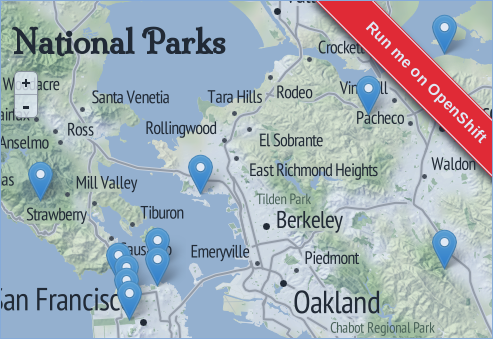Ecosyste.ms: Awesome
An open API service indexing awesome lists of open source software.
https://github.com/ryanj/level-leaflet
an example leaflet map using level-geo
https://github.com/ryanj/level-leaflet
Last synced: 7 days ago
JSON representation
an example leaflet map using level-geo
- Host: GitHub
- URL: https://github.com/ryanj/level-leaflet
- Owner: ryanj
- Created: 2015-02-03T00:47:20.000Z (about 10 years ago)
- Default Branch: master
- Last Pushed: 2015-02-03T00:47:59.000Z (about 10 years ago)
- Last Synced: 2024-12-20T07:26:26.916Z (2 months ago)
- Language: JavaScript
- Size: 117 KB
- Stars: 0
- Watchers: 3
- Forks: 0
- Open Issues: 0
-
Metadata Files:
- Readme: README.md
Awesome Lists containing this project
README
# Map of National Parks and Historic Sites
*powered by RESTify, LevelDB, and Leaflet maps*
[](https://build-shifter.rhcloud.com/job/levelparks-build/) [](https://david-dm.org/ryanj/level-leaflet)
[](https://openshift.redhat.com/app/console/application_type/custom?name=levelparks&cartridges%5B%5D=nodejs-0.10&initial_git_url=https%3A%2F%2Fgithub.com%2Fryanj%2Flevel-leaflet.git)
A basic instant mapping demo using LevelDB, node-restify, LeafLet Maps and map tiles from Stamen, to visualize the locations of major National Parks and Historic Sites.
Related post on OpenShift.com: [https://www.openshift.com/blogs/instant-mapping-applications-with-postgis-and-nodejs](https://www.openshift.com/blogs/instant-mapping-applications-with-postgis-and-nodejs)
## Instant Provisioning on OpenShift
To deploy a clone of this application using the [`rhc` command line tool](http://rubygems.org/gems/rhc), type:
rhc app create parks nodejs-0.10 --from-code=https://github.com/ryanj/level-leaflet.git
Or, [link to a web-based **clone+deploy**](https://openshift.redhat.com/app/console/application_type/custom?name=levelparks&cartridges%5B%5D=nodejs-0.10&initial_git_url=https%3A%2F%2Fgithub.com%2Fryanj%2level-leaflet.git) on [OpenShift Online](http://OpenShift.com) or [your own open cloud](http://openshift.github.io):
https://openshift.redhat.com/app/console/application_type/custom?name=levelparks&cartridges%5B%5D=nodejs-0.10&initial_git_url=https%3A%2F%2Fgithub.com%2Fryanj%2Flevel-leaflet.git
A live demo is available at: [http://levelparks-shifter.rhcloud.com/](http://levelparks-shifter.rhcloud.com/)
## Local Development
Before you spin up a local server, you'll need a copy of the source code, and an installation of [nodejs](http://nodejs.org/).
If you created a clone of the application using the `rhc` command (above), then you should already have a local copy of the source code available. If not, you can try cloning the repo using `git`, or taking advantage of the `rhc git-clone` command to fetch a local clone of any of your existing OpenShift applications:
rhc git-clone parks
OpenShift will automatically resolve `package.json` dependencies for hosted applications as a normal part of it's automated build process. In your local development environment, you'll need to run `npm install` in order to ensure that your application's package dependencies are available:
npm install
### Basic Configuration
This app uses the `config` npm module, which loads it's configuration details from the `config/defaults.json` file. This configuration takes advantage of several environment variables whenever they are available. On OpenShift, many of these values are automatically provided for your application by their associated cartridge add-on service:
module.exports = {
port: process.env.PORT || process.env.OPENSHIFT_NODEJS_PORT || 8080,
ip: process.env.OPENSHIFT_NODEJS_IP || '127.0.0.1',
table_name: process.env.OPENSHIFT_APP_NAME || 'parks'
}
Sensible defaults allow us to run the same code in multiple environments.
#### Starting your Local Webserver
With your dependencies installed, your port-forwarding tunnel established, and your environment variables set, firing up a local server should be as simple as typing:
npm start
Your dev server should be available at the default address: [localhost:8080](http://localhost:8080)
## Deploying updates to OpenShift
When you're ready, you can push changes to your OpenShift-hosted application environment using the standard `git` workflow:
1. Add your changes to a changeset:
`git add filename1 filename2`
2. Mark the changeset as a Commit:
`git commit -m 'describe your changes here'`
3. Push the Commit to OpenShift
`git push`
## License
This code is dedicated to the public domain to the maximum extent permitted by applicable law, pursuant to CC0 (http://creativecommons.org/publicdomain/zero/1.0/)
